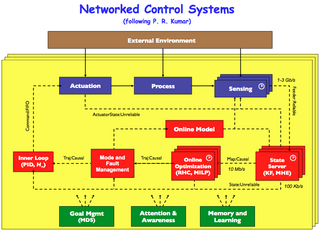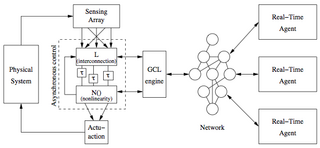Research Overview: Difference between revisions
| Line 34: | Line 34: | ||
* '''Distributed resource allocation''': Many networked control systems must manage a set fixed resources in a coordinated way. These resources can include energy usage, communications bandwidth or | * '''Distributed resource allocation''': Many networked control systems must manage a set fixed resources in a coordinated way. These resources can include energy usage, communications bandwidth or | ||
* '''Automatic synthesis of control protocols''': Next generation networked control systems must also be (at least partly) designed for verification, since it will not be possible to analyze systems of this complexity without structure the design to allow verification tools to be applied. The use of "correct by construction" design methods is one path that shows promise for automatically synthesizing control protocols given a set of specifications describing the required behavior. Preliminary results have demonstrated some possible ways to do this for hybrid systems with nonlinear dynamics and event-driven operations, building on tools developed in the model checking community. | * '''Automatic synthesis of control protocols''': Next generation networked control systems must also be (at least partly) designed for verification, since it will not be possible to analyze systems of this complexity without structure the design to allow verification tools to be applied. The use of "correct by construction" design methods is one path that shows promise for automatically synthesizing control protocols given a set of specifications describing the required behavior. Preliminary results have demonstrated some possible ways to do this for hybrid systems with nonlinear dynamics and event-driven operations, building on tools developed in the model checking community. | ||
Current projects: | Current projects: | ||
Revision as of 19:59, 20 November 2010
This page contains a brief summary of my group's current research activities, broken up into the three main areas that cover 90% of our activities. More information is available on the individual project pages below and also in the recent publications from my group.
Analysis and Design of Biomolecular Feedback Systems
Feedback systems are a central part of natural biological systems and an important tool for engineering biocircuits that behave in a predictable fashion. The figure at the right gives a brief overview of the approach we are taking to both synthetic and systems biology. There are three main elements to our research:
- Systems biology - we are working to develop rigorous tools for analyzing the phenotype of complex biomolecular systems based on data-driven models. We are particularly interested in systems involving feedback, since causal reasoning often fails in these systems due to the interaction of multiple components and pathways. Work in this are includes system identification, theory for understanding the role of feedback, and methods for building and analyzing models built using high-throughput datasets.
- In vitro testbeds - we are making use of both transcriptional expression systems and protein expression systems to develop a "biomolecular wind tunnel" that can be used to characterize the behavior of circuits in a systematic fashion as part of the design process.
- Biocircuit design - engineered biological circuits required a combination of system-level principles, circuit-level design and device technologies in order to allow systematic design of robust systems. We are working on developing new device technologies for fast feedback as well as methods for combining multiple feedback mechanisms to provide robust operation in a variety of contexts. Our goal is to participate in the development of systematic methods for biocircuit design that allow us to overcome current limitations in device complexity for synthetic biocircuits.
Current projects:
- Molecular Programming Project (NSF)
- Networked Feedback Systems in Biology (ARO ICB)
- CAGEN: Critical Assessment of Genetically Engineered Networks (NAKFI)
- Network Science and Engineering: A Theory of Network Architecture (NSF)
Recent papers:
- Tuning a synthetic in vitro oscillator using control-theoretic tools, Christopher Sturk, Elisa Franco, Richard M Murray. Conference on Decision and Control (CDC), 2010.
- Controlling biological networks by time-delayed signals, Gabor Orosz, Jeff Moehlis, Richard M Murray. Philosophical Transactions of the Royal Society - A, 368(1911):439-454, 2009.
- Design of insulating devices for in vitro synthetic circuits, Elisa Franco, Domitilla Del Del Vecchio, Richard M Murray. Conference on Decision and Control (CDC), 2009.
- Regulatory activity revealed by dynamic correlations in gene expression noise, Mary J Dunlop, Robert Sidney Cox, Joseph H Levine, Richard M Murray, Michael B Elowitz. Nature Genetics, 40:1493-1498, 2008.
Networked Control Systems
The area of networked control systems has emerged in the last several years and sought to combine some of the insights from computer science and control to allow analysis and design of systems that consist of distributed computation connected together across a network. One example of the architecture for such a system is show to the right. We are working on a number of areas related to developing fundamental theory that can be applied across a range of networked control systems:
- Design of information flows: Networked control systems include complicated interconnections between subsystems, with nonlinearities and time delays as integral elements of the system model. How do we analyze stability and performance of this class of systems in a way that exploits the structure of the interactions? How do we design the information flows and other elements of the system to obtain desired behavior in the presence of uncertainty?
- Distributed resource allocation: Many networked control systems must manage a set fixed resources in a coordinated way. These resources can include energy usage, communications bandwidth or
- Automatic synthesis of control protocols: Next generation networked control systems must also be (at least partly) designed for verification, since it will not be possible to analyze systems of this complexity without structure the design to allow verification tools to be applied. The use of "correct by construction" design methods is one path that shows promise for automatically synthesizing control protocols given a set of specifications describing the required behavior. Preliminary results have demonstrated some possible ways to do this for hybrid systems with nonlinear dynamics and event-driven operations, building on tools developed in the model checking community.
Current projects:
- Distributed Sense and Control Systems (MuSyC)
- Network Science and Engineering: A Theory of Network Architecture (NSF)
- Specification, Design and Verification of Distributed Embedded Systems (MURI/AFOSR)
Recent papers:
- Stability and Performance of Non-Homogeneous Multi-Agent Systems on a Graph, Stefania Tonetti, Richard M Murray. IFAC World Congress, 2010. Submitted
- Delay-Based Controller Design for Continuous-Time and Hybrid Applications, Javad Lavaei, Somayeh Sojoudi, Richard M Murray. IEEE Transactions on Automatic Control, 2010. Submitted
- Model reduction of interconnected linear systems, Henrik Sandberg, Richard M Murray. Optimal Control Applications and Methods, 30(3):225–245, 2008.
Robotics and Autonomy
Current projects:
- Control Design for Cyberphysical Systems Using Slow Computing (NSF)
- Characterization of Insect Flight Control Systems (ARO ICB)
- Model-Based Design and Qualification of Complex Systems (Boeing)
Recent papers:
- Receding Horizon Temporal Logic Planning, Tichakorn Wongpiromsarn, Ufuk Topcu, Richard M Murray. IEEE Transactions on Automatic Control, 2012.
- A bio-plausible design for visual pose stabilization, Shuo Han, Andrea Censi, Andrew D Straw, Richard M Murray. IEEE/RSJ International Conference on Intelligent Robots and Systems (IROS), 2010.
- Autonomous Driving in Urban Environments: Approaches, Lessons and Challenges, Mark Campbell, Magnus Egerstedt, Jonathan P How, Richard M Murray. Philosophical Transactions of the Royal Society - A, 368(1928):4649-4672, 2010.


